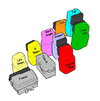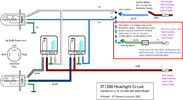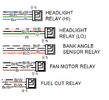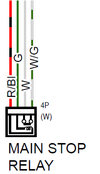Hi
I dont have much time today / tomorrow. Just quick comments.
1. I don't know which 2017 article you are referring to. I cant find one of mine for 20 Aug 17.
2. The diagram that I posted comes from an article that I wrote - linked in the same post. You need to download that article and understand what is going on. The diagram is actually three separate circuits - each of which is described and explained in some detail, (with the irrelevant parts greyed out). In that article I explain that the Bank Angle Sensor is NOT a switch, but that I have represented it as a switch because it turns on or off the Bank Angle Relay. It is actually an electronic device which when 'on' provides enough of a current flow to the coil in the bank angle relay to turn the relay on.
3. You will have a problem if you cannot identify the relays if they have been put back in the wrong positions. That may need to be your first job. I need a diagram to help - hang in, I'll get to my Pc. I'll be back in a tick........
Relay diagram taken from the UK service manual and coloured in. Shown in the relative positions behind the left hand side cover.

Here is the article I referred to
Please excuse the lengthy reply with no diagrams. I have been working through the wiring diagrams getting a grip on what feeds what, and trying to understand the electrical logic behind the Bank Angle Sensor, to make the diagram make sense. But read the bottom bit first - a useful link that I came across. It sounds familiar !!
Anna's Dad's Excellent wiring schematic is linked from Post #1
here.
So this is a sequence starting with the Bank Angle Sensor and checking that power is getting to each point in turn and that leads are intact to that point. You could jump in part way through I suppose, and find a switch relay that is working and move from there. Writing it this way makes it easier to cover all bases.
So I have assumed that the ignition switch is working, that power is getting through the main start relay and that power is getting to the fuses in the fuse box.
Briefly, the bank angle sensor provides a trigger for the bank angle sensor relay. The bank angle sensor relay provides power for the coils and injectors and to fuel cutoff relay (via the Run/Stop switch). The fuel cut off relay activates the fuel pump.
I would guess that with no power to coils or to the pump, the fault has to be the leads, switches and relays up to and including the Bank Angle Senor Relay.
The Bank Angle Sensor has 3 wires.
Black / White - which provides 12v when ignition is on. This comes from the 10A Fuse D in the forward fuse box and is not affected by the Red Runs / Stop switch.
Green which is connected to the chasis earth.
Red / Orange is presumably a signal wire to the bank angle sensor relay and should produce 0-1 volt in the upright position when tested against the green wire (earth)
If the black / white lead gives the +12v reading and the red orange lead doesn't give 0-1v reading then the bank angle sensor must be suspect. The manual doesn't give a reading for when the bank angle sensor is tilted - it just says that the bank angle sensor relay should click. I suspect it would show an open circuit - but I do not know. I also suspect, but I haven't tried this, that the bank angle sensor is providing a return to earth for the relay to be activated. The 0-1v reading is due to the electronic circuitry in the sensor.
The Run / Stop switch has a couple of wires of note.
A
black / white lead which provides the same +12v battery voltage from fuse D that supplies the Bank Angle Sensor. Test it against a good earthing point. There is no earth lead in the switch assmebly.
A
black lead which shows battery voltage (12v) when the switch is on, and takes the +12v to the Bank Angle Sensor Relay. Again, test it against a good earth, with the switch turned on. If power isn't getting to the black/white lead, then there is a problem with the lead or connectors from the fusebox. If power is getting through, but power doesn't appear at the black lead at the switch, then there is a problem with the switch - or the short lead from the switch to wherever you take the reading.
Note that internally, the switch that powers the black lead, also provides power to the engine starter switch.
The Bank Angle Sensor Relay has 4 wires.
Like all basic relays, it has two wires which control the position of the switch (on/off), and two wires which provide the power in and the power out.
Assuming the previous items tested out OK: The
Red/ Orange lead is the one from the Bank Angle Sensor and should display the same 0-1 volt reading when tested against earth. If it doesn't then the red/orange lead, or its connectors at either end must be suspect. I think that this R/O lead is the return to 'earth' lead via the Bank Angle sensor.
The
Black lead is the battery voltage +12v power that comes from the Run / Stop switch. Test against earth, not against the Red / Orange lead - the Bank Angle Sensor has electronics which may not respond if the probes are put on the wrong way round. (My supposition).
Another test: Hold the relay in your hand and turn on the ignition and set the Run/Stop switch to Run. You should feel the click as the relay activates.
The
Black / Pink lead is the source of the battery voltage from the 20A Fuse 'L' in the rearward fuse box. It should read 12v (ish) when measured against a good earth point. If it doesn't, check out the fuse and test the cable from the fusebox to the Bank Angle Sensor Relay for continuity (ie zero resistance).
The
black/white lead from the relay is the battery voltage out of the relay to the next point int he circuit. It should read +12v (ish) when measured against earth when the relay has been activated. (ie when ignition is turned on - if the bank angle sensor is upright AND the Run/Stop switch is set to 'Run'. Check the voltage against a good earth. This black/white lead provides the 12v battery voltage to various devices from this point, including various sensors, the fuel injectors and the ECM. It also provides the voltage for the next stage - the Fuel Cut-off relay.
The Fuel Cut-Off Relay
I have 2 circuit diagrams and the one in my 2004 Honda Workshop manual differs at this point from the superior colour version 'R' that Anna'sDad has produced. If you haven't got it, then download it - it is worth its weight in gold. I'm going with Anna's Dad's version - I trust it to be more accurate for the 2009 model ST1300ABS.
A spur of the
Black/White lead that comes from the Bank Angle Sensor feeds into the Fuel cut-off relay, and is connected to both the trigger and the input voltage contacts. Check that the battery voltage is reaching this point - tested against a good earth. You could also check that the same lead is supplying a voltage to the ignition coils (and to the fuel injectors). There are other sensors too which can be gleaned from the circuit diagram.
The other trigger wire at the Fuel Cut-off relay goes to the ECM - presumably enabling / disabling the return of the trigger voltage to earth. That is the
Brown/Black wire. I would be wary of putting an ohmeter on this - I don't know what the voltage that is put out by the meter might do to the electronics in the ECM.
The
Brown wire is turned on only if the relay has been activated by all of the other switches / relays described above being 'switched on'. If power is reaching this point, then the next stop is the fuel pump.
The Fuel Pump.
Has 3 wires. A
Green wire which is connected to earth. The
Brown wire provides the +12v batter voltage from the Fuel cut-off relay. Test the earth wire for continuity with a good earthing point, or the negative batter terminal. (0 Ohms). Test the brown wire for battery voltage against a good earth (+12v ish). Any fault here must be related to wiring or connectors. The other lead is for the reserve tank sensor.
If everything tests out, then the fuel pump should whirr into life. If it doesn't, you have missed something.
Ignition coils.
Low tension voltage (battery voltage) comes from the black and white leads already mentioned. The
Blue/Yellow and
Yellow/Blue leads (check the colours on the coils 2P connectors) feed straight to the ECM. All you can do is test for continuity (ohmeter) between the multi-pin connector and the coil.
Fuel Injectors.
Ditto the above. Check the colours of the wires feeding each injector (other than the black/white 12v lead) and find the same colours at the multiway connector that plugs into the ECM and check for continuity.
Finally - while checking things out for you I came across this on the forum:
https://www.st-owners.com/forums/showthread.php?97758-ST1300-Brains-required-for-non-starter/page3
It sounds like a very similar problem - and the fault turned out to be a corroded wire which feeds the fuse box - allowing a reading of 12v, but not allowing sufficient current to power anything ! I would guess that someone at some time had put one of those quick wire connectors onto the 12v feed. They slice through the outer protection and the blade contacts the inner core - leaving them open to the elements.
Last edited: Aug 23, 2017







